

1976
 Marye Anne Fox became an Assistant Professor of Organic Chemistry at the University
of Texas at Austin in 1976. From 1976 to 1978 she acted as a consultant,
again in air pollution analysis, for the Texas Air Control Board.
Marye Anne Fox became an Assistant Professor of Organic Chemistry at the University
of Texas at Austin in 1976. From 1976 to 1978 she acted as a consultant,
again in air pollution analysis, for the Texas Air Control Board.  Her
work in Austin was championed early on by Dr. M. J. S. Dewar,
Her
work in Austin was championed early on by Dr. M. J. S. Dewar,  who
held the first Robert A. Welch Chair in Chemistry, and Dr.
Alan J. Bard, who held the Hackerman-Welch Regents Chair in Chemistry
at UT Austin.
who
held the first Robert A. Welch Chair in Chemistry, and Dr.
Alan J. Bard, who held the Hackerman-Welch Regents Chair in Chemistry
at UT Austin.
 In 1980, the Sloan Foundation awarded the Alfred
P. Sloan Research Fellowship to Fox. Selection for this honor is extremely
competitive. The foundation considers top scientists at research universities
early in their careers, in the fields of chemistry, economics, mathematics, neuroscience
and physics. They usually review some 400 nominations per year before selecting
90 Fellows. The Sloan Research Fellowship carries a grant of $30,000 to be used
in an unrestricted manner to support the Fellow's research. The same year
Fox was also recognized with a Camille and Henry Dreyfus Teacher-Scholar Award.
In 1980, the Sloan Foundation awarded the Alfred
P. Sloan Research Fellowship to Fox. Selection for this honor is extremely
competitive. The foundation considers top scientists at research universities
early in their careers, in the fields of chemistry, economics, mathematics, neuroscience
and physics. They usually review some 400 nominations per year before selecting
90 Fellows. The Sloan Research Fellowship carries a grant of $30,000 to be used
in an unrestricted manner to support the Fellow's research. The same year
Fox was also recognized with a Camille and Henry Dreyfus Teacher-Scholar Award.
 Fox
was promoted to Associate Professor of Organic Chemistry at the University of
Texas at Austin in 1981. The following year, she served as a U.S. Delegate -
Observer to the International Union of Pure
and Applied Chemistry (IUPAC) General Assembly, Leuven, Belgium; Electrochemistry,
Physical Organic Chemistry, Photochemistry. The IUPAC serves to advance
the worldwide aspects of the chemical sciences and to contribute to the application
of chemistry in the service of Mankind. Fox continues to serve as a consultant
in these years, working notably for the Polaroid Corporation in organic dyestuffs
and semiconductors.
Fox
was promoted to Associate Professor of Organic Chemistry at the University of
Texas at Austin in 1981. The following year, she served as a U.S. Delegate -
Observer to the International Union of Pure
and Applied Chemistry (IUPAC) General Assembly, Leuven, Belgium; Electrochemistry,
Physical Organic Chemistry, Photochemistry. The IUPAC serves to advance
the worldwide aspects of the chemical sciences and to contribute to the application
of chemistry in the service of Mankind. Fox continues to serve as a consultant
in these years, working notably for the Polaroid Corporation in organic dyestuffs
and semiconductors.
 1984
was a pivotal year for Marye Anne Fox. She traveled to India as a senior
scientist with the U.S. - India Exchange Program. She served as a delegate
with the U.S. - Japan Program of Cooperation in Photoconversion and Photosynthesis.
She was an organizer of a symposium on Organic Photoreactions in Nonhomogeneous
Media, for the Organic Division of the American
Chemical Society and the Inter-american Photochemical Society. She
began a term on the Executive Committee of the Organic Division, American Chemical
Society, and one on the Advisory Board for the Committee on Recommendations
for US Army Basic Research.
1984
was a pivotal year for Marye Anne Fox. She traveled to India as a senior
scientist with the U.S. - India Exchange Program. She served as a delegate
with the U.S. - Japan Program of Cooperation in Photoconversion and Photosynthesis.
She was an organizer of a symposium on Organic Photoreactions in Nonhomogeneous
Media, for the Organic Division of the American
Chemical Society and the Inter-american Photochemical Society. She
began a term on the Executive Committee of the Organic Division, American Chemical
Society, and one on the Advisory Board for the Committee on Recommendations
for US Army Basic Research.
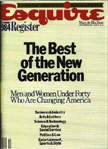 Then
in December of 1984, Esquire Magazine cited her as one of "The Best
of the New Generation - Men and Women Under Forty Who are Changing America."
The national magazine noted her pioneering work in the field of organic
photoelectric chemistry. Her research in photo-induced electron transfer, which
examines how light energy behaves in molecules, has uses in solar energy study
and environmental chemistry. The magazine observed that Fox "may well
have laid the groundwork for the solar powered car." Quoted in 1984 in
her hometown paper the Canton Repository, Fox stated that such an event
was "unlikely to (occur) until the year 2000," and remarked that "what we're
trying to do is devise ways that solar energy can be stored in chemicals, then
at some later time be released. . . It's basic research. Even if
the chemistry came to be understood, you would need delivery systems and an
association of systems for manufacturing the materials needed."
Then
in December of 1984, Esquire Magazine cited her as one of "The Best
of the New Generation - Men and Women Under Forty Who are Changing America."
The national magazine noted her pioneering work in the field of organic
photoelectric chemistry. Her research in photo-induced electron transfer, which
examines how light energy behaves in molecules, has uses in solar energy study
and environmental chemistry. The magazine observed that Fox "may well
have laid the groundwork for the solar powered car." Quoted in 1984 in
her hometown paper the Canton Repository, Fox stated that such an event
was "unlikely to (occur) until the year 2000," and remarked that "what we're
trying to do is devise ways that solar energy can be stored in chemicals, then
at some later time be released. . . It's basic research. Even if
the chemistry came to be understood, you would need delivery systems and an
association of systems for manufacturing the materials needed."
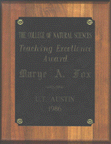 In 1985, Fox was made a full professor of organic chemistry at the University
of Texas. The next year she was bestowed with the Teaching Excellence Award
by the UT College of Natural Sciences, a testament to her often noted commitment
to the classroom. Much has been made of the fact that Fox insisted on
In 1985, Fox was made a full professor of organic chemistry at the University
of Texas. The next year she was bestowed with the Teaching Excellence Award
by the UT College of Natural Sciences, a testament to her often noted commitment
to the classroom. Much has been made of the fact that Fox insisted on 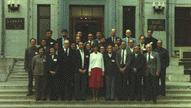 returning to teach her chemistry classes at UT just one week after her second
son, Michael, was born in 1976. But as her colleague Steven Monti, who agreed
to teach her classes while she was on maternity leave, told the Raleigh News
and Observer in April, 1998, "this was not something she did to impress anybody,
this was just how she thought things should be done." According to the N&O,
her students at UT also consistently performed above average in her classes.
returning to teach her chemistry classes at UT just one week after her second
son, Michael, was born in 1976. But as her colleague Steven Monti, who agreed
to teach her classes while she was on maternity leave, told the Raleigh News
and Observer in April, 1998, "this was not something she did to impress anybody,
this was just how she thought things should be done." According to the N&O,
her students at UT also consistently performed above average in her classes.
In 1986 Fox began to serve a five-year term as Director of the Center for Fast Kinetics Research, and was named Rowland Pettit Centennial Professor at the University of Texas that same year. She was also the Vice Chairman of the Gordon Research Conference at Plymouth State College.
 Fox's
mother is perhaps most proud of her daughter's induction, in 1987, into the
Ohio Foundation of Independent Colleges' Hall of Excellence. The Foundation,
which provides scholarships to Ohio students entering and independent college,
inducts alumni who have distinguished themselves in their fields. Fox
shared the honor with Senator John Glenn and Rear Admiral Benjamin T. Hacker,
among others.
Fox's
mother is perhaps most proud of her daughter's induction, in 1987, into the
Ohio Foundation of Independent Colleges' Hall of Excellence. The Foundation,
which provides scholarships to Ohio students entering and independent college,
inducts alumni who have distinguished themselves in their fields. Fox
shared the honor with Senator John Glenn and Rear Admiral Benjamin T. Hacker,
among others.
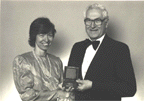 On
June 5, 1988, Marye Anne Fox was awarded the prestigious Garvan Medal by the
American Chemical Society. The medal
is presented each year to "recognize distinguished service to chemistry by
women who are citizens of the United States," and recognized Fox for "her
very original and significant contributions to organic photochemistry and
electrochemistry, in particular photocatalysis of organic reactions by wideband
semiconductors, chemically modified photoelectrodes, and the photochemistry
of organic anions."
On
June 5, 1988, Marye Anne Fox was awarded the prestigious Garvan Medal by the
American Chemical Society. The medal
is presented each year to "recognize distinguished service to chemistry by
women who are citizens of the United States," and recognized Fox for "her
very original and significant contributions to organic photochemistry and
electrochemistry, in particular photocatalysis of organic reactions by wideband
semiconductors, chemically modified photoelectrodes, and the photochemistry
of organic anions."
On December 27, 1988 Fox, along with E. Smotkin and A.J. Bard, was issued a patent for "A Multielectrode Photoelectrochemical Cell for Unassisted Photocatalysis and Photosynthesis." [U.S. Patent 4,793,910]
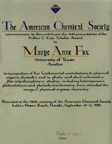 In
1989, Marye Anne Fox was one of nine chemists to receive the Arthur C. Cope
Scholar Award from the American Chemical Society. The award carried
an unrestricted research grant of $15,000. Fox was also a Visiting Scholar
at Harvard University.
In
1989, Marye Anne Fox was one of nine chemists to receive the Arthur C. Cope
Scholar Award from the American Chemical Society. The award carried
an unrestricted research grant of $15,000. Fox was also a Visiting Scholar
at Harvard University.
 In
1991, Marye Anne Fox became the first University of Texas chemist to hold the
M. June and
J. Virgil Waggoner Regents Chair in Chemistry, a position she retained
In
1991, Marye Anne Fox became the first University of Texas chemist to hold the
M. June and
J. Virgil Waggoner Regents Chair in Chemistry, a position she retained  until coming to NC State in 1998. She also received the Havinga Medal from the
Gorleaus Laboratoria der Rijksuniversiteit in Leiden, The Netherlands and served
on the International Scientific Planning Committee, Satellite on "Electron Transfer,"
at the 7th International Congress on Quantum Chemistry in Marseilles,
France. She became a Scientific Advisor for the Camille and Henry Dreyfus
Foundation, and was appointed by fellow Texan, President
George Bush to the National Science
Board, which establishes policies for the National
Science Foundation. The 24-member board oversees the funding for basic
scientific research, awards scholarships and fellowships, and fosters international
scientific exchange. Fox served on the board for five years.
until coming to NC State in 1998. She also received the Havinga Medal from the
Gorleaus Laboratoria der Rijksuniversiteit in Leiden, The Netherlands and served
on the International Scientific Planning Committee, Satellite on "Electron Transfer,"
at the 7th International Congress on Quantum Chemistry in Marseilles,
France. She became a Scientific Advisor for the Camille and Henry Dreyfus
Foundation, and was appointed by fellow Texan, President
George Bush to the National Science
Board, which establishes policies for the National
Science Foundation. The 24-member board oversees the funding for basic
scientific research, awards scholarships and fellowships, and fosters international
scientific exchange. Fox served on the board for five years.
In 1992, Marye Anne Fox traveled to Paris as a Professeur Inviteé at the
Université Pierre et Marie Curie. She served on the US Committee of the International
Union of Pure and Applied  Chemistry
(IUPAC) Conference on Physical Organic Chemistry; she began a two-year term
on the Subcommittee on Federal Funding for Chemistry and a three-year term
on the Committee on Science, both for the American Chemical Society. She began
to serve on the Governors' Executive Board for the Texas Science and Mathematics
Renaissance Centers. She began on ongoing term of service on the Commission
on the Future of the National Science Foundation, and was named an Outstanding
Alumna by her alma matter, Notre Dame College of Ohio.
Chemistry
(IUPAC) Conference on Physical Organic Chemistry; she began a two-year term
on the Subcommittee on Federal Funding for Chemistry and a three-year term
on the Committee on Science, both for the American Chemical Society. She began
to serve on the Governors' Executive Board for the Texas Science and Mathematics
Renaissance Centers. She began on ongoing term of service on the Commission
on the Future of the National Science Foundation, and was named an Outstanding
Alumna by her alma matter, Notre Dame College of Ohio.
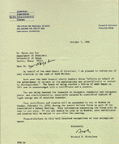 In 1993, Marye Anne Fox traveled to Taipei, Taiwan as a Visiting Professor
in the Chemistry Research
In 1993, Marye Anne Fox traveled to Taipei, Taiwan as a Visiting Professor
in the Chemistry Research  Promotion Center of the National Science Council. She served as a Scientific
Reviewer for the National Center for Science Education, and was on the Steering
Committee on High School Science Education for the Commission on Physical
Sciences, Mathematics, and Resources at the National Research Council. She
was also named a Fellow
of the American Association for the Advancement of Science on February
14, and became Chairman-elect of the AAAS Chemistry Section that same year.
Promotion Center of the National Science Council. She served as a Scientific
Reviewer for the National Center for Science Education, and was on the Steering
Committee on High School Science Education for the Commission on Physical
Sciences, Mathematics, and Resources at the National Research Council. She
was also named a Fellow
of the American Association for the Advancement of Science on February
14, and became Chairman-elect of the AAAS Chemistry Section that same year.
 1994 was another extremely momentous year for Marye Anne Fox. Most notably,
Fox was elected to the National
Academy of Sciences, one of only 101 women historically to have been so
esteemed, and one of only 85 women out of an active membership of 1,710. "I'm
very flattered and honored," Fox said at the time. "It's a very prestigious
group, all of whom are very highly accomplished. It's an honor to be asked to
join their number." Fox was further venerated in 1994 when she was named a Fellow
of the American Academy of Arts and Sciences, one of the oldest traditional
academic societies in the United States. She also received a D.Sc. degree (Honoris
causa) from Notre Dame College, and served on the Secretary of Energy's Advisory
Board, the Taskforce on Alternative Futures, for DOE National Laboratories.
1994 was another extremely momentous year for Marye Anne Fox. Most notably,
Fox was elected to the National
Academy of Sciences, one of only 101 women historically to have been so
esteemed, and one of only 85 women out of an active membership of 1,710. "I'm
very flattered and honored," Fox said at the time. "It's a very prestigious
group, all of whom are very highly accomplished. It's an honor to be asked to
join their number." Fox was further venerated in 1994 when she was named a Fellow
of the American Academy of Arts and Sciences, one of the oldest traditional
academic societies in the United States. She also received a D.Sc. degree (Honoris
causa) from Notre Dame College, and served on the Secretary of Energy's Advisory
Board, the Taskforce on Alternative Futures, for DOE National Laboratories.
Also
in 1994, Fox was promoted to the newly created position of Vice President
for Research at the University of Texas, where she became the highest ranking
woman administrator in the University. She was given the opportunity to design
her own position, and she allowed that 25% of her time be devoted to continuing
with her research. As Fox commented to the UT Faculty Women's Organization,
she looked forward to the challenge to "identify forward-looking research
opportunities that (would) forge new partnerships among the University community,
industry, and state and federal government agencies."
In December Fox visited Antarctica as part of her involvement with the National Science Board.
Fox also began a term on the Executive Committee of the Council of the National Academy of Sciences, and she chaired the NAS Committee on Undergraduate Science Education. She served on the Council of the American Association for the Advancement of Science, and became a Member-at-Large of the AAAS Section on Chemistry. She served on the International Organizing Committee of the International Conference on TiO2 Photocatalytic Purification of Water and Air, and on the Council on Chemical Sciences with the U.S. Department of Energy. Fox was also a member of the Texas Board of the Environmental Defense Fund until her arrival in North Carolina in 1998.
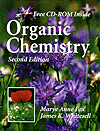 |
In
1997, the first edition of Organic Chemistry by Marye Anne Fox
and James K. Whitesell appeared. The popular textbook included a CD-Rom
which displayed moving
3-d images of molecules, giving students a more realistic picture
of molecular behavior. It was translated into several languages and was
expanded into a second edition in 1998.
Fox served on the Secretary of Energy's Basic Energy Sciences Advisory Committee in 1997, and Cleveland State University conferred the degree of D.Sc. (Honoris causa) upon its former student. |
In
April, the university attracted Lucent Technologies to it's progressive and
imaginative Centennial Campus. In a press conference announcing the partnership,
Fox, an enthusiastic supporter of Centennial Campus, stated:
| The real excitement at our university takes place when our most talented and best people, ideas and technology come together with that of industry and government to enhance the development of dynamic new products, innovative solutions and better service, while educating students to be work-force ready, Centennial Campus provides an unparalleled environment for this to happen. Our alliance with Lucent will be critical to the university's mission of offering a state-of-the-art curriculum that provides our students with real-world applications. |
Fox is a community leader and has become a part of numerous local and national
organizations since arriving in North Carolina such as:
NCSU Libraries | NCSU Libraries' Special Collections | North Carolina State University | Exhibit's Homepage